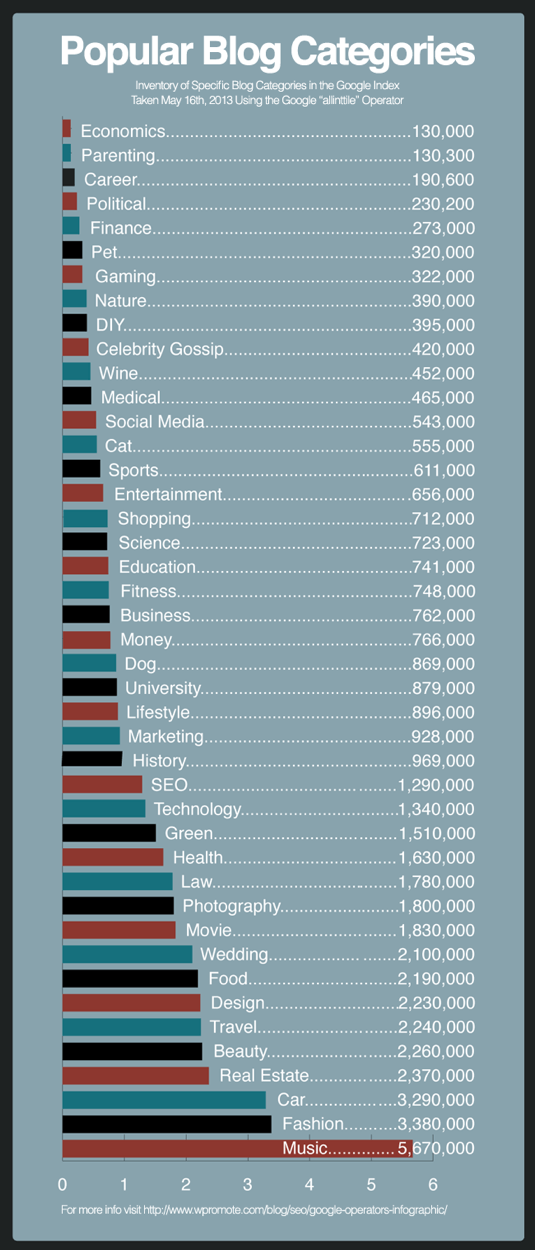
By now, we’ve given you already a lot of different articles about the importance of Content Marketing in today’s world. And we think you know that starting a blog is one of the easiest ways to share your ideas and expertise with the world.
So you’ve decided to give this Content Marketing a “go” for your company and are thinking to yourself what I should do now?
We know that for a lot of people starting a blog sounds like a complicated thing. But is it?
It used to be that you needed to have lots of technical skills and know about all these acronyms like HTML, CSS or PHP. But nowadays starting a blog is almost as simple as sending someone an email. That is if you follow our guidelines we’ve put down in this article for you.
If you follow our step-by-step instructions, you will be able to set up and make your blog, avoiding common mistakes and getting started on the right tracks. And the best thing? No technical skills are required!
Ready? Let’s go!
#1 Choosing your goals
As with any marketing activity, you’ve got to figure out for yourself what your goals are and what you want to get out of it. Content marketing can most of the time put into two different buckets. Content Marketing to create awareness, and marketing to create conversions.
Understanding the difference between the two is vital and already helps you at a later stage to choose the correct blogging platform as well.
Content Marketing to create awareness refers to the tactics you’re using to help increase your brand recognition for your target audience. Awareness marketing strategies focus on making more people aware of your products and service. Making more people aware of how you can help solve their problems for your particular target audience or “buyer personas”.
An example of this is creating a Facebook account and building your fan base. Or around this particular topic of blogging, starting to blog on platforms where it is easy to create a presence for reaching a large audience, but you don’t have control over the content to help convert people. Places like LinkedIn or Medium are ideal for this type of blogging.
Content Marketing to create conversions refers to the tactics you’re using not just to have your target audience read, watch or listen to your content, but have them perform a particular action as well. It focuses on having your target audience complete a specific goal, like having them sign up for your newsletter. For conversion marketing to work, you need more control over your content and how it is displayed. Things like Drupal, Squarespace, Wix and of course our favourite WordPress (but we might be biased ;-)), are perfect for this type of blogging.
Conversion focused content marketing is usually something that is easier to measure, while awareness focused content marketing is mostly easier to execute. This does not mean one rules out the other, you can of course easily repurpose content from your WordPress website on Medium or LinkedIn, but it is important to get the distinction right before you start any content marketing campaign.
#2 Choosing your topics
When thinking about Content Marketing you usually already have a purpose: you’ve got a product or service, and you want to use Content Marketing to promote your business and get new leads and clients.
Content Marketing, after all, is nothing more than:
Content marketing is just solving the same problems that your product solves through media you create and promote.
So coming up with different topics to start writing about should be fairly easy. For any business it is easy to find problems that your (potential) customers are facing, you already knew about those problems because you started your product or service around it to help them fix it. However, there are a lot more verticals related to the problems that you’re solving with your product that could be great topics for your leads to start consuming content about.
You can use Amazon book listings, and social networks, for example, to identify the topics for your blog.
If you’re starting a blog not related to business, but just because you want a place to start writing it might be a bit harder to identify a topic. You can start writing about cooking, politics, parenthood, gaming, sports, etc. the list is endless. Maybe you already have something completely different in your mind.
In the end, it doesn’t matter. As long as you enjoy the topic you want to start writing about and are interested in learning more. The friendly folks behind Wpromote did some research in 2013 and identified some of the most popular blogging categories to help you get started:

#3 Choosing your domain name
If you’re starting a blog as part of your business, this step is easy and can easily be skipped. The best place to put your blog is on your existing domain in a subdirectory like “/blog“. However, if you’re totally new to blogging and you want to start a blog as your primary outlet, your main presence. You need to start thinking about a dominate so that people can find you.
Buying a domain name for a blog can be a fun but also frustrating thing to do. You can spend hours coming up with the most awesome name only to find out the domain name is already taken. Coming up with a name for your blog is almost the same as naming your startup and can be done in four easy steps:
- Word Association
- Generating names
- Generate some more
- Start identifying the gems
If you want to know if your name is available, we recommend using a service like Namechk this also gives you the option to see if related social media accounts are available. If you found a name and it is available, it’s time to take action. Register your name, and move on. The faster you move on, the sooner you can start gaining momentum.
#4 Choosing a blogging platform
Before you start identifying what hosting you need, you first need to determine what kind of software you will be using. You need some form of blogging software or a piece of software that helps you get your content onto the web.
There are many different types of blogging software available, and although most of them are build on a combination of PHP and MySQL, you need to make sure that you know this before you can start looking into hosting.
Even though there are many different types of blogging software available, in our minds the choice is very easy. Setting up a WordPress.org website is the best way to go ahead.
WordPress is by far the most popular blogging software out there, why?
- WordPress is free (This means you are free to download, install, use and modify it. You can use it to create any website. It is also open source which means the source code of the software is available for anyone to study, modify and play with)
- WordPress is easy to use and learn ( WordPress is used by millions of people and almost every day new people are joining the WordPress community by creating their first WordPress powered websites. The reason why people quickly adapt to WordPress is that it is relatively easy to use.)
- WordPress is extendable by using themes and plugins (There are thousands of free and paid templates and plugins out there ready to extend the functionality of your WordPress or give it a professional look and feel)
- WordPress is safe and secure (WordPress has been around for many years and is developed with security in mind, so it is considered quite safe and secure to run any website. However, just like the real world, the internet can be an uncertain place. So make sure to keep your installation up-to-date)
Of course, you’re free to use any other platform. In the end, blogging software is just a tool. So be sure to use the one that you feel most comfortable with.
#5 Getting a web hosting account
The next two steps are the most technical steps of the bunch. The first of these is about the hosting of your website. To give a little bit of background information on what is happening as soon as you type in an URL in your browser, the folks behind WhoIsHostingThis have created this helpful four step visualisation.

In other words, your web hosting is the place on the internet where your website is hosted. If someone tries to access your site, your browser will get all the necessary images, and other content from a web server. So basically, without a domain (so people can type in something in their browser) and without web hosting, it is impossible for people to find you and consume your content.
The two are inseparable! There are a lot of different options out there, but most of the time companies where you can register a domain name offer the option for hosting your website as well. We host our website at Rackspace, but there are a lot of choices to choose from. Most of the time, prices for something like this start at around $10 per month.
Make sure that the option you choose supports the blogging platform you choose in the previous step, though.
After you got yourself a web hosting account, it’s time to setup your WordPress installation. Web hosting company Bluehost, created a great tutorial series on YouTube, on how to setup your WordPress:
https://www.youtube.com/playlist?list=PL_9u00nsHteH2OBVX4YSU_HWWY_JSxFyj
#6 Selecting a blog design and layout
First impressions count for a lot, so you’ll want to make sure that whenever someone visits your blog for the time, it says something about the type of brand you are or trying to create. Something that will make you stand out from all the other websites already out there.
Creating a visual identity for your brand can seem like a big task for now, so one of the quick ways to start is by using all of the amazing designs that are already (freely) available.
Let’s start by making your WordPress installation look exactly the way you want it.
Once you’re WordPress is installed, and you’re logged into the backend of your installation go to:
Appearance > Themes here you can install a new theme by pressing “Add New”.
You can either choose from one of the widely available free themes here, or you can upload a theme that you bought somewhere else. A good place to look at premium themes is ThemeForest.net, where you can buy professional looking themes for around $40.
The beautiful thing about WordPress is that with just a couple of simple click like this, you can have a professional looking website up and running in minutes. And because it is so easy, when you’re not happy with your current design anymore you can always change it again at a later stage.
Remember, the design you choose should reflect you and your (company’s) personality, and of course, it should be inline with the topic your blog is about. There is no point in having a food orientated theme when your website is about marketing right?
Next, to that, you want to make sure that the design you choose is easy to the eye and easy to navigate if you want people to stick around. But the most important thing, with the biggest amount of traffic coming via mobile nowadays it should be designed mobile first.
#7 Start creating useful content that adds value to your readers
The hardest part is now done, it’s time to start producing content! Within WordPress, there are roughly two types of content. Posts and Pages
Posts
Posts will be the types of content that you will be working with most of the time. They are what makes the blogging the blogging part.
In a standard installation, posts will appear on the front page of your blog in chronological order as soon as you hit publish. Most of the time, you can see a date to show when the posts were published and your readers have the possibility to comment on them.
Pages
Pages are the ‘static’ content on your website (we used parentheses here because of course these can be updated at any time). Most of the time these are important enough though to have a separate link to them from your menus and navigation area of your blog.
For example, here at Inbound Rocket, these are the “About Page”, “Install Page”, “Support Page”, “Features Page” and the “Contact Us” page.
The first page you want to be making should probably be the “About Page”. New readers arriving at your website are probably curious who is behind your blog, and it can give them some background information what the blog is about and what drives you to make it.
After you hit publish on your “About Page” it is time for probably the scariest moment of all, writing your first blog post and hitting “publish” on your first post.
#8 Start converting your visitors
Once people are starting to find your blog, it is time to think about the next steps. You need to start converting those visitors into email subscribers and building your email list.
Your list will become the biggest asset of your blog and your potential business that might come out of it in the future.
Social media sites come and go. Remember MySpace? It was the biggest thing happening at the time; people put in a lot of effort into building a presence there and right now it is pretty much a ghost town.
Of course, Facebook and all the other social sites are a great way to get some more reach, but you need to be careful. The first thing to be careful about is the way any social media platform might change its rules and how you can reach your contacts, or they might close down altogether. Remember, having a more than 20% reach on your Facebook page without paying?
The second thing might be that a social media platform might lose its reach and people move over to a different platform.That is the reason why you need to start converting people on your property, on your blog.
There are lots of different plugins out there, that can help you to convert visitors on your website, but our favourite is, of course, our own.
Have you started a blog?
If this article pushed you over the edge and finally made you start your blog to start with content marketing, we’d love to hear from you in the comments below. Let us know what type of blog you started and what kind of pitfalls you ran into and how you solved them. Together we can tackle the fear of starting a company blog for your business.

